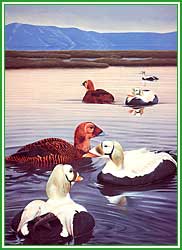 |
Spectacled EiderSomateria fischeri |
|
U.S.F.W.S. Spectacled Eider Wintering Area Spectacled Eiders: Threatened Sea Duck on the NPR-A http://wwwndo.ak.blm.gov/npra/sympos/html/paper23.html
Spectacled Eider (Somateria fischeri) populations in western Alaska have declined precipitously since the late 1970's. Subsequently, the species was listed as threatened in 1993. To investigate the potential causes of the decline, we developed a deterministic model of Spectacled Eider population dynamics based on demographic data we collected on the Yukon-Kuskokwim Delta, Alaska, from 1991-1996. The model incorporated estimates of nest success, clutch size at hatch, duckling survival, age of first reproduction, and adult female survival collected at a two locations. We assumed that survival of immature females during their first year was 85% of adult female survival, because immature survival was unknown. In the sensitivity analysis, adult female survival was the most important parameter affecting the rate of population growth. We demonstrated the requirements for nest success, duckling survival, and adult female survival to achieve a stable population. We compared the expected rates of population growth at the two sites, demonstrate the potential importance of lead poisoning to population recovery, and identified research needs to improve the population model. Philopatry In Nesting Adult Female Spectacled Eiders At
Kigigak Island, Yukon Delta National Wildlife Refuge, Alaska In response to the dramatic decline of the species (early 1970's to 1990's) on the Yukon-Kuskokwim Delta, I conducted a nesting ecology study on spectacled eiders (Somateria fischeri) at Kigigak Island from 1992-1996. The Kigigak Island population has had relatively high nest success between 1992-1996 (92%, 63%, 70%, 64%, and 82%, respectively). More than 50% of the nesting females have been marked (n=161). Preliminary results show that 70% of the marked females have returned to nest at least once following their banding year and that 52% returned at least two consecutive years. The spectacled eider estimate on Kigigak is relatively high compared with return rates reported for other duck species, including buffleheads (Bucephala albeola)( 44-50%) and mallards (Anas platyrhynchos) (40-46%). Preliminary results also show that returning females move an average of 200 m from previously used nest sites. I am currently examining relationships between partial predation, clutch size, nesting chronology and distances moved between individual female's nest sites. Molecular Genetic Characterization Of Spatial
Population Structuring In Contemporary And Historical Populations Of The
Threatened Spectacled Eider |
|
